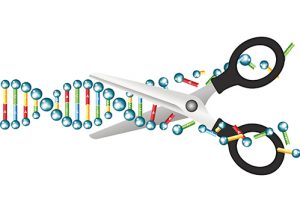
DNA editing carries profound implications for basic science, medicine, and many other fields. Gene editing can be used for a variety of different things including research, to treat disease, and for biotechnology. Gene editing can be used to change the DNA in cells or organisms to understand their biology and how they work. Genome editing has also been used to modify human blood cells that are then put back into the body to treat conditions including certain types of cancer, such as leukemia. It can even screen unborn children for diseases before conception. It has potential for the treatment of infections including MRSA and genetic conditions such as muscular dystrophy and hemophilia. Additionally, genome editing has been u sed in agriculture to genetically modify crops to improve their yields and for resistance to disease and drought. It has also been used to genetically modify cattle.
Genome editing uses a type of enzyme called an “engineered nuclease” which cuts the genome in a specific place, thereby altering it. Afterward, the cell naturally repairs itself. Scientists are able to manipulate this repair process to make changes—or edits—to the DNA in that location in the genome. There is also the possibility of removing a section of DNA in order to prevent certain diseases or conditions such as those mentioned above.
The development of the Clustered Regularly Interspaced Short Palindromic Repeats (CRISPR) genome editing tool in 2012 has made it possible to precisely engineer cuts and/or edits in DNA at any target sequence, giving researchers unprecedented power and ease to manipulate any genome of their choosing. Scientists have already reported huge strides using CRISPR to fix disease genes in animal models and human embryos, and clinical trials for blindness, muscular dystrophy, and cancer are imminent. Scientists have also engineered the pig genome to enable safer organ transplants and are contemplating so-called gene drives to wipe out malaria.
Gene editing can be used to help treat disease but it also raises some important ethical and legal questions related to access, equity, safety, and the specter of human enhancements. Some of the ethical questions that arise have to do with creating “designer babies.” Ethicists are debating the power of CRISPR and whether it is right to allow parents to filter out traits they deem undesirable. Another issue is accessibility. While such advances in gene editing can be helpful in eradicating genetic disorders and certain diseases, the ability to edit DNA to prevent one’s child from living with chronic conditions such as Huntington’s disease will only be available to an elite class of extremely wealthy people.
However, some people believe that even with CRISPR we will not be living in a world free from genetic diseases. One of the reasons is that some important diseases are “polygenic,” meaning that more than one gene is responsible for the condition. And it can often be the case that there are hundreds of genes responsible for any one condition. One example is the case of autism. Researchers believe that as many as 1,000 genes may play a role in the development of autism, meaning there is no single gene that can be identified as “the autism gene.”



